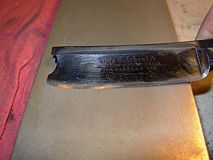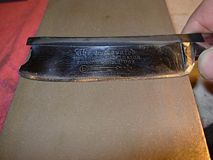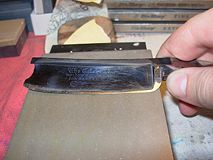Difference between revisions of "Rolling X stroke"
m (Fixed typo) |
m (Added categories, fixed sequence.) |
||
| Line 11: | Line 11: | ||
</gallery> | </gallery> | ||
| − | Some different shots. | + | Some different shots. This set shows how to do it without any X pattern necessary. |
<gallery caption="" widths="240px" heights="160px" perrow="3"> | <gallery caption="" widths="240px" heights="160px" perrow="3"> | ||
Image:The Rolling XDSCN2435.jpg | Again razor with a ridiculous smile to show the motion. | Image:The Rolling XDSCN2435.jpg | Again razor with a ridiculous smile to show the motion. | ||
| − | Image:The Rolling XDSCN2434.jpg | If you look close, you can see that the razor does not touch the stone at the toe or heel | + | Image:The Rolling XDSCN2434.jpg | If you look close, you can see that the razor does not touch the stone at the toe or heel. |
| − | + | Image:The Rolling XDSCN2433.jpg | That is why the straight honing method does not work for it. | |
</gallery> | </gallery> | ||
| Line 23: | Line 23: | ||
<references /> | <references /> | ||
| + | |||
| + | |||
| + | [[Category:Tutorials]] | ||
| + | [[Category:Honing]] | ||
Revision as of 06:08, 3 October 2008
Originally posted by Russel Baldridge.[1]
I don't know if anyone will get much out of this, but I took a few shots the other day while I was honing because there had been some discussion about "the rolling X" pattern for honing. The razor is one with a very pronounced smile, and the motion has been exaggerated to show the essence of what's happening. Each razor will require a different degree of "roll" in the honing stroke, so just take this as a basic instruction, you'll need to use your own judgement when implementing it.
The motion is the same for both sequences, only the first one does a "rolling X" pattern, while the second set focuses on the "rolling hone" which goes straight down the length of the stone.
Some different shots. This set shows how to do it without any X pattern necessary.


